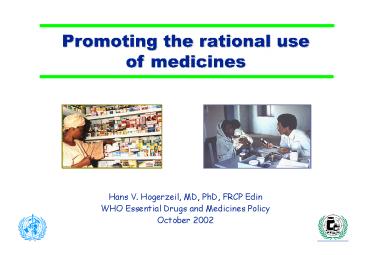WHO Essential Drugs Strategy - PowerPoint PPT Presentation
1 / 29
Title:
WHO Essential Drugs Strategy
Description:
Thailand 1991: 79% of surgical antibiotic prophylaxis is inappropriate (choice, ... Supply of drugs. Treatment guidelines. Treatment choice. Prevention. and care ... – PowerPoint PPT presentation
Number of Views:85
Avg rating:3.0/5.0
Title: WHO Essential Drugs Strategy
1
Promoting the rational use of medicines
Hans V. Hogerzeil, MD, PhD, FRCP Edin WHO
Essential Drugs and Medicines Policy October 2002
2
Overview of the presentation
- Access framework
- Examples of irrational use of medicines
- Measuring drug use (indicators)
- How to promote rational prescribing
- Proven effective interventions
- Probably effective interventions
- Probably ineffective interventions
- Promoting rational prescribing in the private
sector
3
Practical implications of the access framework
Access framework
4
Irrational use of medicinesis a widespread
hazard to health
Example irrational use
- Only half of 102 countries surveyed regulate drug
promotion - In some areas, by age 2 children have had more
than 20 injections - 15 billion injections aregiven per year - and
half of them are unsterile
5
Published examples of irrational prescribing in
teaching hospitals in developing countries
Example irrational use
- Yemen 1990 68 of hypertensive patients receive
diazepam 80 of UTI receive furosemide, 80 of
osteoarthritis receive vitamins - Ilorin 1991 33 of inpatients are on
tranquillizers - Kathmandu 1992 Only 70 of medicines prescribed
are from the national list of essential medicines - Thailand 1991 79 of surgical antibiotic
prophylaxis is inappropriate (choice, dose and/or
duration) - South Africa 1991 54 of antibiotic treatment in
gynaecology inpatients is inappropriate
6
Examples of irrational prescribing from 4800
general practices in the UK (1995)
Example irrational use
- Ulcer healing medication used presumptively
- In 0-90 of patients,SSRIs have replaced
tricyclic antidepressants - In 0-56 of patients, buspirone has replaced
diazepam (300x as expensive) - 0-97 of patients on beta-blockers receive
long-acting betablockers (16-25x as expensive) - Other inhalors prescribed instead of salbutamol
(cost 8x) - Combination medicines (cost up to 16x)
7
How to measure irrational drug use?WHO/INRUD
indicators (1)
Measuring drug use
- Prescribing indicators
- Average number of drugs per encounter (lt2)
- Percentage of drugs prescribed by generic name
(close to 100) - Percentage of encounters with an antibiotic
prescribed (lt30) - Percentage of encounters with an injection
prescribed (lt10) - Percentage of drugs prescribed from EDL or
formulary (close to 100)
8
How to measure irrational drug use?WHO/INRUD
indicators (2)
Measuring drug use
- Patient care indicators
- Average consultation time
- Average dispensing time
- Percentage of drugs actually dispensed (100)
- Percentage of drugs adequately labelled (100)
- Patients knowledge of correct dosage (100)
- Facility indicators
- Availability of copy of EDL or formulary (100)
- Availability of key drugs (100)
9
Promoting rational prescribing Proven effective
interventions
Interventions
- Standard treatment guidelines, when
evidence-based, developed with end-users, with
active dissemination and follow-up - Essential Medicines lists, when linked to
treatment guidelines and used for training and
supply - Hospital Drugs and Therapeutic Committees
- Undergraduate training
- Comprehensive approach, with all components
10
The Essential Medicines Target
Selection
National list of essential medicines
Registered medicines
All the drugs in the world
Levels of use
CHW
S
S
dispensary
Health center
Supplementary specialist medicines
Hospital
Referral hospital
Private sector
11
Clinical guidelines and a list of essential
medicines lead to better prevention and care
Selection
List of common diseases and complaints
Treatment choice
Treatment guidelines
Essential medicines list / National formulary
Training and Supervision
Financing and Supply of drugs
Prevention and care
Health Technology and Pharmaceuticals
12
Example of challengeNew essential drugs are
expensive
Challenges
- Antibiotics for gonorrhoea 50-90x price of
penicillins - Antimalarial drugs chloroquine 0.10 per
treatment artemether-lumefantrine 2.50/pp
(25x) atovaquone-proguanil 40/pp (400x) - Antituberculosis 15 for DOTS vs 300 for MDR
(20x) - Antiretrovirals 300-600/year but 38 countries
with a drug budget lt2 pp/year
13
WHO Model List of Essential Drugs
Selection
- 1977 First Model list published, 200 active
substances - List is revised every two years by WHO Expert
Committee - Last revision (April 2002) contains 325 active
substances - 2002 Revised procedures approved by WHO
The first list was a major breakthrough in the
history of medicine, pharmacy and public health
Médecins sans Frontières, 2000
14
The WHO Model List of Essential Medicines is
amodel product, model process and public health
tool
Selection
- Model product list of essential drugs with
information - Core list minimum drug needs for a basic health
care system, listing the most cost-effective
drugs for priority conditions (selected on the
basis of public health relevance and potential
for safe and cost-effective treatment). - Complementary list essential drugs for which
specialised diagnostic or treatment facilities
may be needed
15
WHO Essential Medicines LibraryCombining
information from various partners
Selection
WHO clusters
WHO/EDM
Summary of clinical guideline
Clinical guideline
BNF
WHO Model Formulary
WHO/EC, Cochrane
Reasons for inclusion Systematic reviews Key
references
WHO Model List
WHO/EDM
MSH UNICEF MSF
Cost - per unit - per treatment - per month -
per case prevented
Statistics - ATC - DDD
Quality information - Basic quality tests -
Intern. Pharmacopoea - Reference standards
WCCs Oslo/Uppsala
16
The WHO Model List of Essential Medicines is
amodel product, model process and public health
tool
Selection
- Model process example for national committees
- Independent Membership of the Committee, careful
consideration of conflict of interest - Transparent process, standard application, web
review - Link to evidence-based clinical guidelines
- Systematic review of comparative efficacy,
safety, cost-effectiveness and public health
relevance - Rapid dissemination, electronic access
- Regular review
17
The essential drugs concept is nearly universal
a floor, not a ceiling - applied differently in
different settings
Achievements
By Dec.1999 156 countries with EDLS 1/3 within
2 years 3/4 within 5 years
Countries with an official selective list for
training, supply, reimbursement or related health
objectives. Some countries have selective
state/provincial lists instead of or in addition
to national lists.
18
Treatment guidelines and formulary manuals put
the essential drugs concept into clinical practice
Achievements
? 135 countries have treatment guidelines,
formularies
19
Training in rational prescribing has expanded in
universities throughout the world
Achievements
DAPs role
- Problem-based pharmacotherapy
- In 21 languages
- For medical students, clinical officers
- Measurable improvement in prescribing
- Now also Teachers Guide to Good Prescribing
20
Interventions
Impact of problem-based pharmacotherapy
teaching on examination scores (Argentina,
1999-2002)
1999(n802)
52
36
9,5
2,4
41,5
37,6
15
5,9
2000(n559)
40
36
16
2001(n855)
6,9
25,2
42,7
24,4
8,4
2002(n131)
0
20
40
60
80
100
3
4-5
6-7
gt 8
21
Example of an indicator survey time
seriesPercent prescriptions by generics, from
EDL, and actually dispensed (Delhi State,
1995-2000)
Measuring drug use
Percent
Year under review
22
Trends in research From drug utilisation to
cost-effective intervention (1)
- Drug utilisation studies
- tend to be descriptive, aggregated data
WHAT?
- SO WHAT?
- Indicator studies
- more focused on rational drug use WHAT? ? HOW
MUCH? - Qualitative studies WHY?
23
Trends in researchFrom drug utilisation to
cost-effective intervention (2)
- Intervention studies HOW MUCH? WHY?
(intervention) HOW MUCH NOW? Conclusion ? DOES
IT WORK? IS THE INTERVENTION EFFECTIVE? - Management studies IS THE INTERVENTION
REPRODUCABLE?IS IT COST-EFFECTIVE?
24
Trends in researchExample Is it reproducable
and cost-effective?
- Mexico (1992-1994) Research District State
Adequate treatment Diarrhoea
change 46.7 25.6 29.3 ARI
change 32.6 28.8 8.5 - Cost-benefit ratioDiarrhoea 3.3 3.9
4.4 ARI 16.2 18.4 21.6
Source Guiscafre et al. Arch Med Res 1995 26,
Supp. S31-39
25
Promoting rational prescribing Interventions
which need more testing
Interventions
- Probably effective
- Drug sellers interventions
- Public education
- Changing fee structure
- Probably ineffective
- Drug information bulletins and other printed
materials - Banning ineffective/dangerous medicines
- Arbitrary prescription limitations, counter
signatures - Traditional stand-up lecturing
26
Promoting rational prescribing Possible
interventions in the private sector
Interventions
- Regulation market approval, re-licensing,
re-evaluation per therapeutic category,
regulation of promotion - Training basic training, national clinical
guidelines, continuing medical education by
universities and professional bodies,
re-licensing of professionals on basis of
education points, district DThCommittees, medical
audit, patient information leaflets, public
education - Financial incentives separate prescribing from
dispensing, dispensing fee (flat or tiered),
price controls on generic/brand drugs,
contracting out - Insurance reimbursement limited to essential
medicines, reference pricing
27
Where to start in countries with a strong
private sector?
Interventions
- Regulation market approval, re-licensing,
re-evaluation per therapeutic category,
regulation of promotion - Training basic training, national clinical
guidelines, continuing medical education by
universities and professional bodies,
re-licensing of professionals on basis of
education points, district DThCommittees, medical
audit, patient information leaflets, public
education - Financial incentives separate prescribing from
dispensing, dispensing fee (flat or tiered),
price controls on generic/brand drugs,
contracting out - Insurance reimbursement limited to essential
medicines, reference pricing
28
Conclusion
- Good experiences, policy advice, training tools
and national expertise are available - Future of essential medicines lies with the
public sector and insurance systems - There are many effective interventions possible
for the private sector
29
Thank you
www.who.int / medicines































